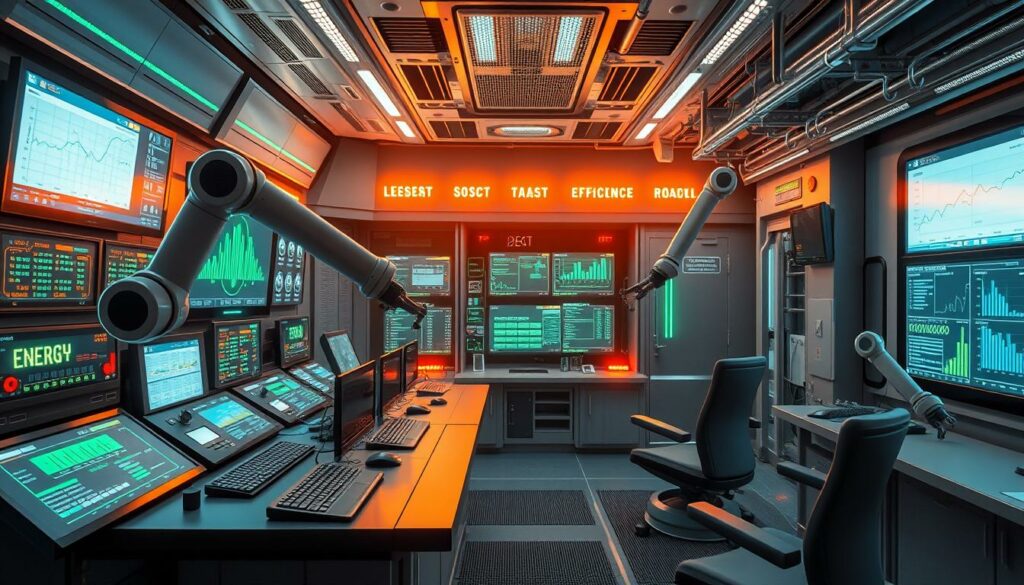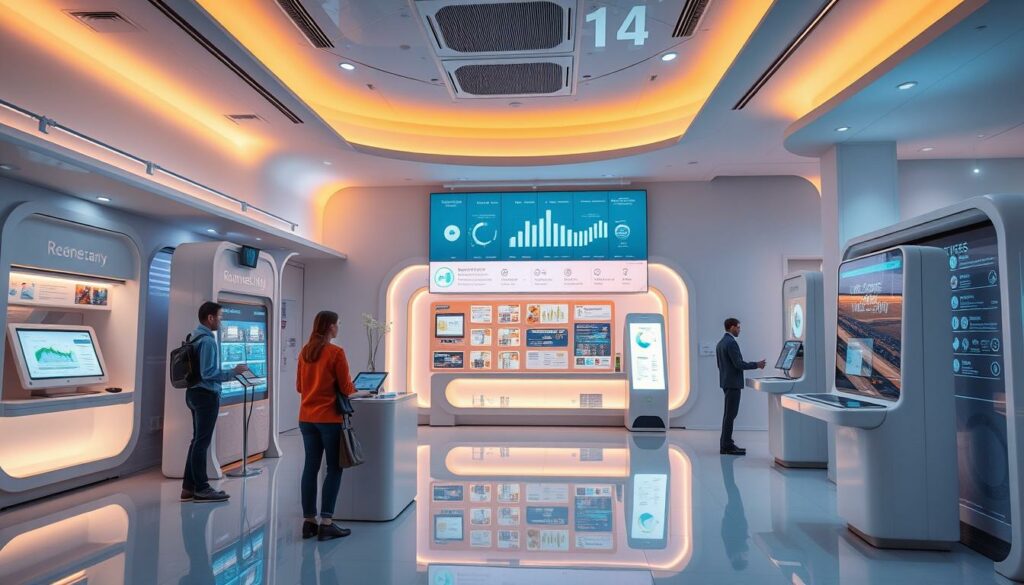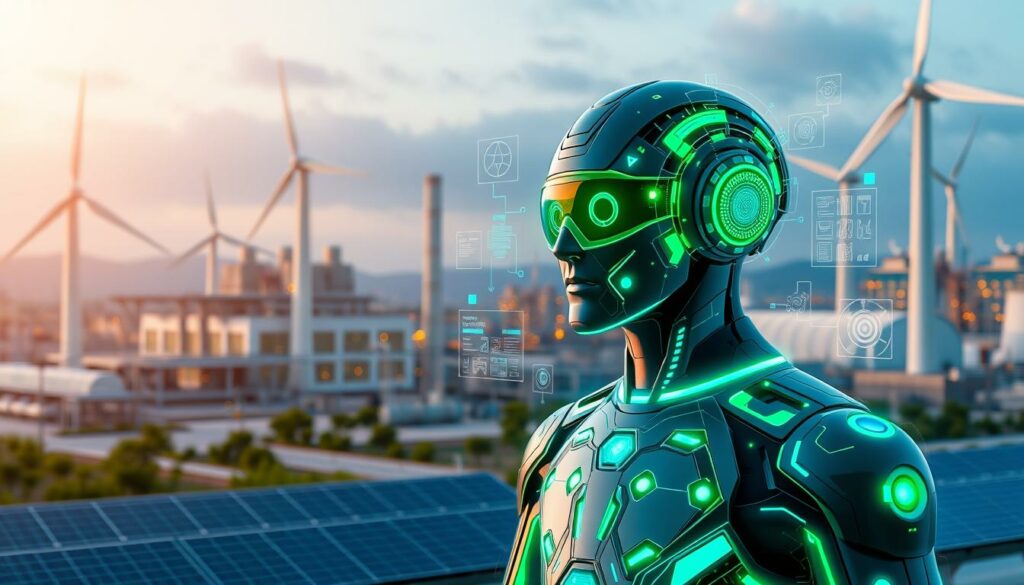The energy sector is known for its slow tech adoption. It often relies on manual work and faces many challenges. But, AI agents can change the game. They offer ways to improve efficiency and spark innovation.
ADNOC and AIQ have teamed up to start ENERGYai. It’s an AI solution aimed at transforming the energy sector. It will make operations more efficient, sustainable, and precise. This puts the UAE at the forefront of AI-enabled energy innovations.
Key Takeaways
- ENERGYai aims to speed up the creation of geological models by up to 75%.
- It will use 80 years of ADNOC’s data and begin real-world tests by the end of 2024.
- It could reduce planning times from 1-2 years to just weeks, cutting costs and emissions.
- A collaboration between AIQ, G42, and Microsoft will offer real-time industry insights.
- AI has great potential to optimize both traditional and renewable energy operations.
Introduction to AI in the Energy Sector
The energy sector is changing fast because of artificial intelligence (AI). A big move in this area is the use of energy industry chatbots. These chatbots use AI to solve problems. They are helping with talent shortages and maintenance predictions, with a 36% adoption rate in businesses.
AI improves how the energy sector works and makes decisions. For instance, ENERGYai has improved efficiency. It also supports caring for the environment. Energy companies like ADNOC are turning to data for solutions.
Generative AI is key during the shift to new energy sources. It makes systems safer and more transparent. It also boosts efficiency. This change affects three key areas in the energy sector:
- Electric generation
- Demand response
- Renewable energy
The benefits of using AI in energy are huge. For power plants, AI helps make operations better by looking at data. This includes fuel costs and market prices. For demand response, AI predicts when to reduce power use. This maximizes benefits.
Renewable energy gets a boost from AI too. It can forecast how much energy wind and solar will produce. It even anticipates natural gas demand. This shows how flexible AI is.
Yet, using AI in energy faces hurdles. Problems include scattered data and old infrastructures. Cybersecurity and rules are also big issues. Still, AI helps tackle big challenges like:
- Improving electricity demand forecasts
- Predicting transmission outages
- Lowering the risk of cyberattacks
- Bettering grid operations
This tech also finds ways to use energy better and sees market changes. The growing power use by data centers shows the need for AI. It helps manage energy needs well.
In summary, artificial intelligence agents are changing energy for the better. There are big opportunities and challenges ahead. They need ongoing creativity and investments.
Optimizing Operations with AI Agents
In the energy sector, using AI agents to make operations better is a big step forward. These agents help with automation of routine tasks, like handling invoices and updating customer accounts. This cuts down on manual work, letting people focus on important stuff like financial planning and assessing risks.

AI is great for predictive maintenance in the energy world. It uses past data and real-time info to foresee maintenance needs. This cuts downtime and makes critical equipment last longer. It really helps with managing renewable energy, preventing expensive problems.
ENERGYai leads the way in using AI for CO2 storage planning and development. By automating tasks and analyzing data, ENERGYai aims to cut costs and emissions. This makes managing energy both greener and cheaper.
AI doesn’t just help with maintenance. It’s also changing how energy is distributed, leading to better grid management. Using smart algorithms, AI ensures energy supply meets demand efficiently. This is key in reducing costs.
- AI automates routine tasks like invoice processing and account updates.
- Predictive maintenance reduces downtime and extends equipment lifespan.
- ENERGYai supports CO2 storage planning, reducing costs and emissions.
- AI-enhanced energy distribution optimizes grid management.
The table below shows how AI automation impacts the energy sector:
| AI Functionality | Impact |
|---|---|
| Predictive Maintenance | Reduced Downtime, Enhanced Equipment Lifespan |
| AI Automation of Routine Tasks | Improved Operational Efficiency |
| Energy Distribution Optimization | Efficient Grid Management |
| CO2 Storage Solutions | Minimized Costs and Emissions |
Energy companies can greatly improve by adding advanced AI solutions. This makes managing energy more dependable and efficient. AI’s ability to automate tasks and predict needs will change the energy sector for the better. It leads to greener and more cost-effective energy solutions.
AI Agent for Energy Industry: Enhancing Sustainability
Using an artificial intelligence agent in the energy field helps lower the carbon footprint. It makes the industry more sustainable. About 43% of executives use AI to watch the environment. They make choices that are good for the planet. This shows how crucial AI is for a greener future.
The growth of energy industry chatbots has made work safer. It has also reduced harmful emissions. Generative AI helps companies stick to eco-friendly goals. It makes operations both safer and more efficient. These AI systems analyze huge data quickly. They predict how much energy we will use. They ensure resources are used well. And they lessen mistakes people might make.
ENERGYai is creating AI that makes operations more efficient and green. Their technology focuses on accurate data. This allows for better control of energy use. AI cuts costs and helps the environment. Adopting such tech creates big changes.
India wants to add up to 30 gigawatts of solar power. This is part of the prime minister’s Surya Ghar Yojana plan. It’s a big move towards being eco-friendly.
AI is key to fixing energy problems in places like India. The country loses over 15% of energy in transmission and distribution annually. That’s three times more than the United States loses. India plans to put in 250 million smart meters. AI will help make these systems smarter and policies better.
In Australia, they use virtual power plant systems to manage energy. This includes adding renewable energy to the grid. A new kind of AI, like GPT-4 with vision, is proving very useful. It looks at drone footage to help manage the energy grid better.
| Region | AI Utilization | Benefits |
|---|---|---|
| India | Smart Meters & Solar Capacity | Enhanced Efficiency, Job Creation, Reduced T&D Losses |
| Australia | Virtual Power Plant Systems | Load Balancing, Grid Management, Renewable Integration |
| United States | Regulations for AI | Privacy Controls, Model Transparency, Enhanced Accountability |
For more about how AI is changing energy for the better, visit here. AI plays a big part in making energy use smart and green.
AI for Customer Engagement and Personalization
In today’s energy sector, using artificial intelligence improves how companies interact with customers. Companies like Octopus Energy are now using AI to handle customer emails. This makes customer service better through personalized messages.
A report by the International Data Corporation (IDC) says that by 2024, 45% of energy suppliers will use AI, like chatbots. This will make customer service better and reduce the need for calls to help centers by more than 60%. This move to AI shows a big change in the energy sector towards using more AI.

“Generative AI is changing the game for energy companies in dealing with customers. It allows for very personalized service and greatly improves the customer’s experience,” observed a report from the CapGemini Research Institute.
A study from the CapGemini Research Institute found that 33% of utility companies are thinking about using generative AI for customer service. Yet, 41% of energy companies are waiting before they use this technology. They are cautious because managing data can be hard, with issues like different data sources and names.
Companies such as ENERGYai are using generative AI to make customer service better and offer personalized energy advice. These advances are improving customer service and happiness. They are creating new standards for how the energy sector interacts with customers.
| Company | AI Implementation | Outcomes |
|---|---|---|
| Octopus Energy | AI for managing emails | High customer satisfaction |
| ENERGYai | AI for customer service and personalizing solutions | Enhanced interaction and satisfaction |
To sum up, using AI for customer engagement in the energy field leads to very personalized and improved services. By adopting AI, utility companies can stay ahead, be more productive, and save costs. This all leads to improving customer service.
AI in Renewable Energy Management
AI is changing the way we use renewable energy. A market analysis shows 54% of executives believe AI is key for integrating renewable energy. It helps with storage control and keeping the power supply steady. This is a big step forward for managing energy.
AI helps manage the smart grid, too. It uses smart agents to better forecast supply and demand. This makes switching to renewable energy smoother. Generative AI turns these forecasts into plans. This helps use resources well and keeps the grid stable.
ENERGYai shows how AI can help with renewable energy. It makes detailed simulations that help plan, reduce work time, and lower emissions. These tools are very important for making energy use both green and cost-effective today.
| Core Functions of AI in Renewable Energy | Impact and Benefits |
|---|---|
| Predictive Maintenance | Minimizes downtime and enhances infrastructure reliability. |
| Energy Storage Management | Optimizes storage and release times to improve energy reliability. |
| Smart Grid Management | Balances supply and demand, enhancing grid stability. |
| Demand Response Management (DRM) | Adjusts electricity usage during peak periods to stabilize the grid. |
| Renewable Energy Forecasting | Analyzes weather and historical data to predict energy generation. |
AI does more than just manage grids and storage for renewable energy. It also looks into market trends for smarter energy trading. Plus, it makes buildings smarter and more energy-efficient with smart meters. It even helps investors check projects and analyze risks. The role of AI in shaping the energy sector is huge and only getting bigger.
Conclusion
The global AI energy market is soaring. It’s expected to reach $7.78 billion by 2024. This shows that using AI technology in the energy sector is crucial, not just a passing trend. Companies are turning to digital assistants to boost energy production, cut carbon emissions, and save costs. At the same time, they’re making operations safer and more appealing to customers. However, overcoming the challenges like unfamiliarity with the technology and resistance to change is key.
Big players in the energy field, such as Shell, Chevron, and Saudi Aramco, are already on board. They are incorporating AI into their operations, setting an example of the industry’s future. By using AI, wind energy efficiency could go up by 20%. This tech could also cut solar energy costs by between 10-15%. Plus, smart grids, optimized by AI, could boost energy reliability by 25%. They could also decrease losses in distribution by as much as 30%. These are big steps toward a green future.
For the energy industry, making the most of AI technology is key for future progress. AI can help save up to 20% on energy costs. It can also cut down energy waste by 15-20%. ADNOC has developed ENERGYai, a big leap in using AI within the energy field. This move shows the potential for increased efficiency, sustainable practices, and leadership in energy management on a global scale. So, investing in AI for energy management is a smart choice. It will lead to innovative breakthroughs, keeping the energy sector vital in our digital era.
FAQ
What role does an AI agent play in the energy industry?
An AI agent improves many operations in the energy sector. This includes things like predictive maintenance and finding talent. It makes routine jobs automatic, helps with smart decisions, and introduces better ways to manage energy.
How can AI enhance sustainability in the energy sector?
AI helps lower the carbon footprint by watching the environment and making greener decisions. Tools like ENERGYai are used to plan how to store CO2 on a big scale. They cut down emissions and support eco-friendly actions in this field.
What are the benefits of using AI for customer engagement in the energy sector?
AI makes customer service better by quickly handling questions and tailoring messages and answers to each person. This way of personal touch boosts happiness and engagement with customers. A good example is how Octopus Energy does it.
How does AI technology support renewable energy management?
AI helps add renewable energy sources by better managing storage, predicting supply and demand, and improving smart grids. For instance, ENERGYai helps in making detailed plans and pushing forward renewable energy projects.
What is predictive maintenance, and how does AI improve it?
Predictive maintenance uses AI to spot equipment issues before they happen. This cuts downtime and extends machinery life. Tools like ENERGYai look at data to foresee when maintenance is needed. This makes operations smoother and less expensive.
How does AI in the energy sector improve operational efficiencies?
AI takes over simple jobs, aids in smarter decision-making, and betters operational methods. By studying lots of data, AI agents give tips that make energy creation, sharing, and usage more efficient. This leads to big operational gains.
What is the impact of AI on talent acquisition in the energy industry?
AI overcomes challenges in hiring by automating the recruitment process. It finds the top candidates using data analysis and handles onboarding. This makes the hiring process faster and more effective, ensuring the right skilled people are brought on board quickly.



